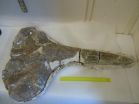(Press-News.org) From computers, tablets, and smartphones to cars, homes, and public transportation, our world is more digitally connected every day. The technology required to support the exchange of massive quantities of data is critical. That's why scientists and engineers are intent on developing faster computing units capable of supporting much larger amounts of data transfer and data processing.
A new study published in Nature Photonics by Tel Aviv University researchers finds that new optical materials could serve as the nuts and bolts of future ultra-high-speed optical computing units. According to the research, led by Dr. Tal Ellenbogen and conducted by group members Nadav Segal, Shay Keren-Zur, and Netta Hendler, all of the Department of Physical Electronics at TAU's School of Electrical Engineering and TAU's Center for Nanoscience and Nanotechnology, these "nonlinear metamaterials," which possess physical capabilities not found in nature, may be the building blocks that allow major companies like IBM and Intel to move from electronic to optical computing.
At his TAU lab, Dr. Ellenbogen studies the interaction between light and matter at the nanoscale level in order to explore underlying physical mechanisms, which can be used to develop novel optical and electro-optical components. "Optical metamaterials have been studied for their intriguing and unusual properties for the last 15 years," said Dr. Ellenbogen. "Our work shows that, with the proper design, they can also be used to develop new types of active optical components essential to the manufacture of ultra-high-speed optics-based computer chips."
Light and matter
In natural materials, the interaction between light and the material is governed by the chemical composition of the material. In the new optical materials, however, through the creation of fine nanostructures, the interaction can be controlled and new optical phenomena can be observed. When the strength of the interaction is not directly proportional to the strength of the light field, nonlinear optical effects kick in. These effects can be used to make active optical devices.
From electronics to photonics
These artificial optical materials are sometimes referred to as optical metamaterials and their nanoscale building blocks are sometimes referred to as "optical meta-atoms." "Future on-chip communications systems are expected to change from relying solely on electronics to relying on photonics -- that is, the qualities and mechanics of light -- or hybrid electronic-photonic systems," said Dr. Ellenbogen. "These photonic on-chip communications systems will consist of active nonlinear nanoscale optical elements. Our research opens the door to consider nonlinear metamaterials as the active nanoscale components in future on-chip communications.
"By merging two disciplines in optics -- metamaterials and nonlinear photonic crystals -- we are opening the door to constructing novel active nonlinear devices based on metamaterials and to new fundamental studies altogether," said Dr. Ellenbogen. The researchers are currently exploring how to make the nonlinear interaction more efficient by using multilayered metamaterial structures and by examining different metamaterial building blocks.
INFORMATION:
All of the research was conducted at the Laboratory for Nanoscale Electro-Optics at TAU's Center for Nanoscience and Nanotechnology, and was supported by the Israel Science Foundation, the European Commission Marie Curie Career Integration Grant, and the Tel-Aviv University Center for Renewable Energy. For this research Nadav Segal won the The Feder Family Award for Best Student Work in Communications.
American Friends of Tel Aviv University supports Israel's most influential, most comprehensive and most sought-after center of higher learning, Tel Aviv University (TAU). US News & World Report's Best Global Universities Rankings rate TAU as #148 in the world, and the Times Higher Education World University Rankings rank TAU Israel's top university. It is one of a handful of elite international universities rated as the best producers of successful startups, and TAU alumni rank #9 in the world for the amount of American venture capital they attract.
A leader in the pan-disciplinary approach to education, TAU is internationally recognized for the scope and groundbreaking nature of its research and scholarship -- attracting world-class faculty and consistently producing cutting-edge work with profound implications for the future.
TORONTO, March 18, 2015--Researchers have defined a new bodily process in mice that may explain why blood oxygen levels are lower for patients with cystic fibrosis when they get a lung infection.
"Infected areas of the lung are not as capable as healthy tissue at adding oxygen to the bloodstream, but no one has shown why this is the case," said Dr. Wolfgang Kuebler, a scientist in the Keenan Research Centre for Biomedical Science of St. Michael's Hospital. "We've shown that the protein produced by a gene known as CFTR is required to direct blood flow away from infected ...
This news release is available in Spanish. Using discarded electronic boards, the UPV/EHU researcher Andoni Salbidegoitia has, in collaboration with international researchers, developed a system for obtaining clean hydrogen that can be used as fuel. The researchers have already registered the patent of the process in Japan.
The Chemical Technologies for Environmental Sustainability (TQSA) Group of the Department of Chemical Engineering of the UPV/EHU's Faculty of Science and Technology is aiming to make use of discarded plastic as effectively as possible from the ...
Bats are not as stereotyped when they hunt as previously believed. New research shows that these flying mammals are capable of making ultra-fast decisions about how to attack their prey - or maybe even call off the attack. It takes only milliseconds.
Bats use echolocation for orientation. They emit ultrasonic sounds, which hit potential prey nearby, sending an echo back to the bat. From this echo the bat can define where the prey is and attack it. A new study has examined how hunting bats react when approaching their prey. The study concludes that bats are capable of ...
Imagine a loved relative suffering from cancer - and you could not afford a treatment because the drugs are too expensive. The Austrian Centre of Industrial Biotechnology (acib) developed a method with the power to reduce production costs of highly valued drugs significantly.
Without antibodies we would be at the mercy of pathogens or cancer cells. Therapeutic antibodies are used as passive vaccines, for cancer therapy or for controlling autoimmune diseases such as multiple sclerosis. According to "bccresearch.com" the global market for antibody drugs was worth nearly ...
Researchers have fine-tuned a technique for coating gold nanorods with silica shells, allowing engineers to create large quantities of the nanorods and giving them more control over the thickness of the shell. Gold nanorods are being investigated for use in a wide variety of biomedical applications, and this advance paves the way for more stable gold nanorods and for chemically functionalizing the surface of the shells.
Gold nanorods have a lot of potential applications, because they have a surface plasmon resonance - meaning they can absorb and scatter light. And by ...
This news release is available in Spanish. Alzheimer's disease is the most significant cause of dementia in the elderly: it affects over 35 million people worldwide. It is reckoned that Alzheimer's could reach epidemic proportions in developed countries unless therapies to cure or prevent it are obtained. Studies conducted so far reveal that the therapies are more effective when they are applied before the brain has become severely damaged. What is more, the spotting of early phases of the disease may help to develop new treatments. Right now, to make a clinical diagnosis ...
A new microarray-based tool, called VaginArray, offers the potential to provide a fast, reliable and low-cost assessment of vaginal health and diagnoses of infections. The research is published ahead of print March 2, in Antimicrobial Agents and Chemotherapy, a journal of the American Society for Microbiology.
The VaginArray has 17 probe sets, each one specific for one of the most representative bacterial species inhabiting the vaginal ecosystem, including those associated with both healthy and unhealthy conditions. Each probe set is designed to be complementary to the ...
ALBUQUERQUE, N.M. -- Researchers at Sandia National Laboratories' Z machine have helped untangle a long-standing mystery of astrophysics: why iron is found spattered throughout Earth's mantle, the roughly 2,000-mile thick region between Earth's core and its crust.
At first blush, it seemed more reasonable that iron arriving from collisions between Earth and planetesimals -- ranging from several meters to hundreds of kilometers in diameter -- during Earth's late formative stages should have powered bullet-like directly to Earth's core, where so much iron already exists.
A ...
This news release is available in French. Basic research on blood pressure has led researchers from Inserm (Inserm Unit 1138, "Cordeliers Research Centre") to obtain unexpected results: drugs used to treat hypertension (high blood pressure) reduce side effects from corticosteroid-based creams used to treat certain skin diseases.
This work is published in the Journal of Investigative Dermatology.
Corticosteroid-based dermatological creams are indicated for the symptomatic treatment of inflammatory skin conditions, such as atopic dermatitis and psoriasis, for example. ...
Uplift associated with the Great Rift Valley of East Africa and the environmental changes it produced have puzzled scientists for decades because the timing and starting elevation have been poorly constrained.
Now paleontologists have tapped a fossil from the most precisely dated beaked whale in the world -- and the only stranded whale ever found so far inland on the African continent -- to pinpoint for the first time a date when East Africa's mysterious elevation began.
The 17 million-year-old fossil is from the beaked Ziphiidae whale family. It was discovered 740 ...



